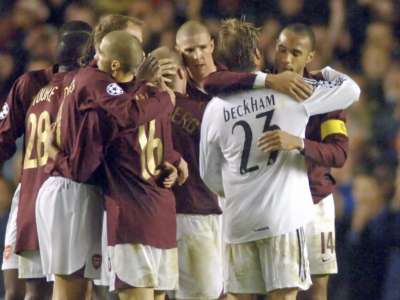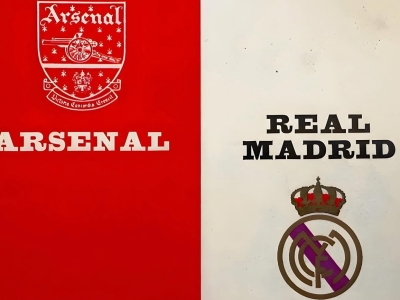The phrase ‘Arsenal DNA’ has been thrown around a lot over the last few years, and it has been taken as read that we all understand exactly what it means. While to an extent the meaning is obvious, it is arguably the players who sum up what Arsenal is as a club and who we all adore. People that spring to mind when you say Arsenal DNA, for me at least, are Tony Adams, Thierry Henry, Pat Rice and Rachel Yankey. These are all fantastic awe-inspiring players, but it is a tad tricky to pin down what the DNA of the club really is.
In the Arsenal of the ‘60s, you were more likely to see us finish mid table, and the highlight of each game was Peter Storey kicking the living daylights out of someone. The ‘71 double was a bit of a stand-alone season of pure glory. It is difficult to believe that 30 years later the Marble Halls would be graced with the Invincibles. An even more pressing question is, how did we go from the great Herbert Chapman period of dominance and ground-breaking indigeneity to the complete change in playing philosophy and periods in the shadows that lay ahead, and still have a DNA that remains there to this day?
Well, I would venture that it doesn’t lie in the playing style, players or success of the club. It is something that is more in the nature of the running of the club. Arsenal is a ground-breaking club. That is what links all of our great sides. Don’t believe me? Well read on and be enlightened. Consider the first great period of Arsenal greatness, the ‘30s, the Chapman era, the time that means - unlike every Chelsea fan on the planet - we can say that we have history. In fact, we were the creators of history.
Interestingly, if it were up to Sir Henry ‘I’m obviously a villain, just look at my moustache’ Norris, Herbert Chapman might never have been hired. Norris cited the sacking of Leslie Knighton as one of his greatest regrets.
But, without Chapman would we have had the stranglehold we had on football? To give you the short answer, no, definitely not. Under Chapman’s watchful eye, Arsenal were revolutionaries who built the foundations of modern football.
Here is a list of things Arsenal led the way in:
1. First team to add coloured hoops to their socks so that teammates could more easily pick each other out
2. Pioneers of numbers on the backs of shirts
3. First team on the radio: not only was it Arsenal, it was Arsenal vs Arsenal Reserves
4. First team to play under floodlights
5. First team to play on the television (and on Match of the Day a fair bit later)
6. The WM was revolutionary.
7. The training and the way that fitness was monitored was far beyond that of other clubs.
None of this would have been possible without Chapman, and, honestly, that’s just a snapshot of what he did. And if it were up to Norris, we would have been denied this, because he was suspicious of Chapman’s more professional approach to the game. Chapman favoured the passing game which had originated in Scotland and which he had established at Huddersfield Town. This approach to the game was distrusted by traditionalists like Norris. Chapman was a visionary. The formation that he implemented was as innovative as the Total Football of the ‘70s and tika-taka in the 2000s. I would urge you to read other people’s work on the subject of what the WM did for the game more widely.
But for the purposes of this piece, I think the best thing to say is that Cliff Bastin and Ted Drake both played in this formation and both have terrifyingly good goal-scoring records. Bastin, as we all know, held the Club’s top scoring record until a certain Mr Ian Wright broke it in the ‘90s. Ted Drake scored 42 goals in 41 league appearances in his first full season for the club (1934-35). This is in no small part because they were playing in a side that played in a way that was completely new, which allowed them to be a man up in most attacking scenarios.
The George Graham era seems to be somewhat overlooked by the fans nowadays. But this is a mistake, because Graham was an Arsenal man, who played an important role in the ‘71 double. The thing that always shocks me about Graham as a player is that he was predominantly a flair player, which is at odds with his legacy as a manager, which is ‘that’ back four.
Many fans think this era was far from revolutionary, but I disagree. Not many people remember that the ‘91 team would have gone unbeaten had they not lost to Chelsea on the last day of the season. Of course, we all know what happened on the 26th of May 1989 when a certain someone went charging through the midfield, and there are many people that hold that as the greatest moment in the club’s history (my Mum insists that it was better than the Invincibles, but as a child of the Wenger Era I have to go with them. It’s a really lovely argument to be able to have, isn't it?).
But back to George. It was George who gave us so much of what it is to be ‘Arsenal’. Tony Adams IS Arsenal and it was George who gave him the armband, which for years gave primary school teachers on playground duty the hilarious experience of watching 4 to 10-year-olds in a not quite straight line stand with arms aloft, screaming at a non-existent ref who failed to give offside. (Officiating at a playground level really is a joke. Do they not realise that for that 30 seconds I was Tony Adams?) That is all Graham. I was doing that aged 10 in the height of the Wenger Era, because discipline and positional awareness were stand-alone in the game at the time. That, undoubtedly adheres to the idea of what Arsenal DNA is.
And then came Arsène, and nothing was the same again. To be clear, I was two and a half when Le Professor took the helm and I love him totally and unashamedly. He was a genius. Everything he did was new and exciting.
The training changed; nutrition was considered for the first time. He is someone that Tony Adams credits as a huge help in, not only in his battle against alcoholism, but in extending his career and life. Frankly, if that was the only thing that Arsène did, I think giving us another six years of TA is enough to call him a hero. But Wenger did so much more and was so much more. He changed what it is to be a football manager. No hairdryer half-times with him; he was a thinking man for a thinking man’s club. The way that he went about extending careers was incredible. How often do any of us take time to consider just how mind-blowing it is that it was the same back four that won at Anfield in ‘89 that won the ‘98 double?
Even more amazingly, Martin Keown, who started his career with the club in 1983, received a league-winners medal in 2004 (but, more importantly scared the crap out of Van Nistelrooy in the process). Wenger’s recruitment, particularly in the first half of his tenure, was unrivalled. We all know the list of great names that he, and David Dein, managed to bring to the club. That was because Wenger saw things in players that others didn’t. Vieira and Henry were not then the hot properties they would go on to be.
As a youngster, I was convinced that there was a magic place in France where amazing footballers would wait for Arsène to find them (mad though that seems looking back in this age of constant coverage), where he could find a 19-year-old French winger no one had heard of who went on to be one of the greatest strikers of all time. The closest to that we’ve come to that in recent times is possibly Kanté, though it seems unlikely that he will have the longevity that Henry had.
In the Wenger era the number of firsts, and the amount of new ground broken by the club, were completely unprecedented. One of the things that is rarely mentioned enough is that, while building and paying off the Emirates, Wenger kept the club in the Champions League and challenging for titles, all with no real budget to speak of. That is phenomenal in terms of man- and squad-management. Of course. we could, and have, and will again, talk about the doubles and the Invincibles. But we know that’s fabulous, don’t we?
This ground-breaking nature is club-wide, Arsenal Women (formerly Arsenal Ladies), are the most successful side in women's football. During Vic Akers’ time in charge, they won 32 major trophies, including a quadruple in 2007 (yeah you heard that right, Man Utd fans). The club was the first in the women's game to go entirely professional and remains a huge force within the game. They had to wait decades for their competitors to reach their level.
Even within the realm of fan interaction and inclusivity, the club are streets ahead. According to The Equality and Human Rights Commission we are the only Premier League team to adhere to all the inclusivity measures put in place for disabled fans. So, I suppose that is what ‘Arsenal DNA’ is. It’s to be at the cutting edge of football. We are leaders, we are for everyone, we are The Arsenal.
_______________________________________________________________
The campaign to save The Gooner for the 2020/21 season is in progress. If you wish to see the fanzine continue printing after the end of the current season, details of how to subscribe can be found here. If you wish to order with a credit card, go straight to our online store page here. We need to secure 1,000 subscribers to continue, although the original deadline of 28th March pushed back until we know what will happen with the remainder of the season and can bring out a final issue for the current campaign.
The current issue of The Gooner (282) is on sale from our online store. You can order your copy here (for UK orders) or if you are abroad, order here.








